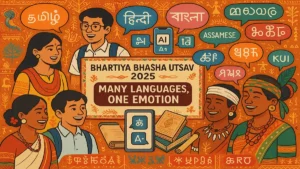In a significant recognition of Gujarat’s rich cultural heritage, the traditional artisans of ‘Kutch Ajrakh’ have been bestowed with the prestigious Geographical Indication (GI) certificate by the Controller General of Patents, Designs, and Trademarks (CGPDTM). This remarkable achievement celebrates the intricate textile craft that has been deeply rooted in the vibrant region of Kutch for centuries.
The Art of Ajrakh
Ajrakh is a textile craft that holds a revered place in the cultural tapestry of Gujarat, particularly in the regions of Sindh, Barmer, and Kutch, where its legacy spans millennia. The art of Ajrakh involves a meticulous process of hand-block printing on treated cotton cloth, culminating in intricate designs infused with rich symbolism and history.
The name “Ajrakh” is derived from the word “Azrak,” meaning indigo, a well-known substance most often employed as a powerful dye to achieve a bluish effect. Traditionally, Ajrakh prints consisted of three colors: blue, representing the sky; red, signifying the land and fire; and white, symbolizing the stars.
A Unique Dyeing and Printing Process
The creation of Ajrakh textiles involves a laborious process where the fabric undergoes a washing cycle eight times. The fabrics are treated with vegetable and mineral colors, ensuring their vibrant hues and longevity.
A Legacy Spanning Centuries
The art of Ajrakh has been practiced in the Kutch region for over 400 years, introduced by the Sind Muslims. This craft has been deeply woven into the cultural fabric of the region, with nomadic pastoralist and agricultural communities like the Rabaris, Maldharis, and Ahirs wearing Ajrakh printed cloth as turbans, lungis, or stoles.
Preserving Cultural Heritage
The conferment of the GI tag on Kutch Ajrakh is a remarkable achievement, recognizing the skill and dedication of the artisans who have preserved this ancient craft for generations. This recognition not only celebrates the rich cultural heritage of Gujarat but also serves as a testament to the importance of safeguarding traditional arts and crafts.
Promoting Sustainable Livelihoods
The GI tag is expected to provide a significant boost to the local artisans and their communities, ensuring the continued preservation and promotion of this unique textile art form. By providing legal protection and recognition, the GI certification aims to promote sustainable livelihoods and empower the local communities to continue their age-old traditions.
As we celebrate the conferment of the GI tag on Kutch Ajrakh, we are reminded of the enduring legacy of Gujarat’s vibrant cultural heritage and the importance of preserving and promoting traditional arts and crafts for generations to come.




 Bhartiya Bhasha Utsav 2025: Celebrating ...
Bhartiya Bhasha Utsav 2025: Celebrating ...
 Starlink Internet: Revolutionising Globa...
Starlink Internet: Revolutionising Globa...
 Google 2025: Top Searches by Indian User...
Google 2025: Top Searches by Indian User...







